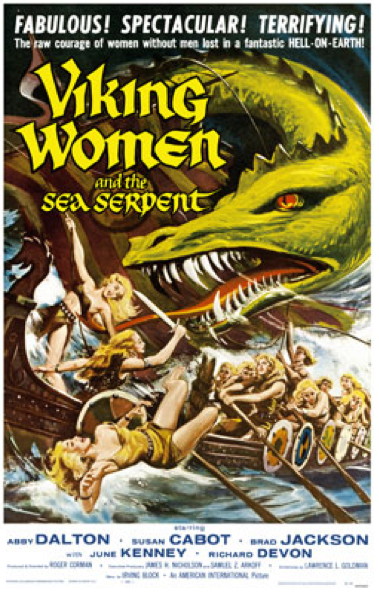
THE SAGA OF THE VIKING WOMEN AND THEIR VOYAGE TO THE WATERS OF THE GREAT SERPENT
US, 1957, 71 minutes, Colour.
Abby Dalton, Susan Cabot, Bradford Jackson, Richard Devon, Jonathan Hayes.
Directed by Roger Corman.
The B Feature was a popular aspect of the double bills, especially in English-speaking countries. They were churned out by the American industry as well as by the British from the 1930s to the 1960s. The coming of television did not immediately halt their production or popularity but, at the beinning of the 1960s, with the big-budget widescreen films that were becoming more and more popular, there was little place for these films.
When the Americans began making telemovies in the late 1960s, these became the alternative to the B films.
However, there were still a number of film-makers who made genre pictures during the 1970s, often Z budget in production and imagination. Later, the successors of these films were the straight-to-video and straight-to-DVD films of the 1990s and into the 21st century.
In the United States, especially with the popular serials that took on themes of science and even space exploration, the 1950s saw a proliferation of short science fiction films, some of them now considered excellent examples of their type, others were just schlock.
One of the features of these films was the atomic age and many of the films were warnings about radiation dangers and the possibilities of mutations and monsters. Godzilla emerged from this period. Space also fascinated film-makers and audiences at this time. The first Sputnik was launched in 1957 and soon after the first astronauts went into space. The moon landing was in 1969. Many of the films (even Kubrick’s 1968 2001: a Space Odyssey) tried to imagine what space travel would be like. There was a huge spate of space films.
Unfortunately, special effects were quite limited at the time and many audiences would find these quite risible. However, taken in their time, they had their impact.
This was the period of Ed Wood and his Planet 9 from Outer Space but also the beginning of the career of Roger Corman and his many protégés who became top-class directors.
There had been a Hollywood tradition of horror since the 1930s which led to many spoofs. However, all kinds of horror made a comeback in the 1950s, not only in the shockers from the US but also from Hammer Studios in England. These films also continued throughout the 1960s and 1970s and influenced some of the poorer directors like Ted. V. Mikels with films like The Corpse Grinders. These films, along with the popularity of the blaxploitation films now show their age with their characteristic costumes and hair styles, the touch sometimes of the psychedelic and the grainy film stock.
Roger Corman began directing films in 1955 with Swamp Woman and Five Guns West. Fifty-five films later, with Frankenstein Unbound in 1990, he had made a great number of B-budget, small running time features on all kinds of themes. However, in the early 1960s he began a series of rather more upmarket adaptations of stories by Edgar Allen Poe (Fall of the House of Usher, Mask of the Red Death, The Haunted Palace …). At that time he also made the significant film against racism in the US, The Intruder with William Shatner. In the late 1960s he went somewhat more upmarket with such films as The St Valentine’s Day Massacre and The Red Baron.
The Saga of the Viking Women is really basic film-making. It is the kind of screenplay that a student beginning film-writing might come up with. The focus is on a group of women whose husbands have been lost at sea. They go in search of them, rowing a boat (that seems to have no space for food or water) and are set upon by a great sea serpent. When they land on the coast, they are taken prisoner by the kingdom who lives there. The king has imprisoned the Vikings and has them working in a mine.
Most of the action is fairly predictable. There is a rather strong hunting scene. There is a carousing scene at a dinner. We see the Vikings in the prison. The women meet them. The king places great hopes on his son who is a weak man and is rescued by the Viking queen from a charging boar. Ultimately, one of the Viking women (played by Susan Cabot who was to appear in Corman’s The Wasp Woman) betrays the others. The leader of the women (Abby Dalton) and her betrothed (Brad Jackson) are tied to a stake and asked to plead for mercy to be spared. The evil Viking woman has a change of heart, prays to the gods – and a storm arises with the rain dousing the fires. The Vikings escape, pursued by the king and his minions – and the sea serpent appears again only to let the Vikings go and destroy the pursuers.
The acting is very basic, some of it not particularly good acting at all. Susan Cabot as the evil Enger stands out as successful. Jonathan Hayes as the weak son appeared in very many of Corman’s films as did Richard Devon as the king of the country.
This was the year Richard Fleischer’s The Vikings came out, with Kirk Douglas, Tony Curtis and Janet Leigh. There are no comparisons.